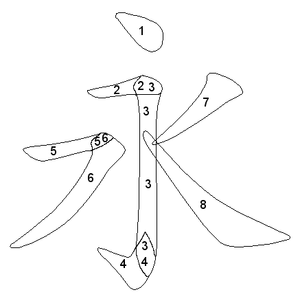Eight Principles of Yong
| Eight Principles of Yong | |||||||||||||||||||||
| Chinese | 永字八法 | ||||||||||||||||||||
|---|---|---|---|---|---|---|---|---|---|---|---|---|---|---|---|---|---|---|---|---|---|
|
|||||||||||||||||||||
| Transcriptions | |
|---|---|
| Standard Mandarin | |
| Hanyu Pinyin | Yǒngzì Bā Fǎ |
| Wade–Giles | Yung3tzu4 Pa1 Fa3 |
| Hakka | |
| Romanization | Yúnsṳ̀ Pat Fap |
| Yue: Cantonese | |
| Jyutping | Wing5zi6 Baat3 Faat3 |
| Southern Min | |
| Tâi-lô | Íngjī Pat Huat |
The Eight Principles of Yong (Chinese: 永字八法; pinyin: Yǒngzì Bā Fǎ; Japanese: 永字八法/えいじはっぽう, eiji happō; Korean: 영자팔법/永字八法, Yeongjapalbeop; Vietnamese: vĩnh tự bát pháp 永字八法) explain how to write eight common strokes in regular script which are found all in the one character, (pinyin: yǒng, "forever", "permanence"). It was traditionally believed that the frequent practice of these principles as a beginning calligrapher could ensure beauty in one's writing.
The Eight Principles are influenced by the earlier Seven Powers (七勢) by Lady Wei Shuo (衛鑠) of Eastern Jin. Publications on the Principles include:
Note: ![]() - Xié 斜 is sometimes added to the 永's strokes. It is a concave Shù falling right, always ended by a Gōu, visible on this image.
- Xié 斜 is sometimes added to the 永's strokes. It is a concave Shù falling right, always ended by a Gōu, visible on this image.
In addition to these eight common strokes in 永, there are at least two dozen strokes of combinations which enter in the composition of CJK strokes and by inclusion the CJK characters themselves.
...
Wikipedia




